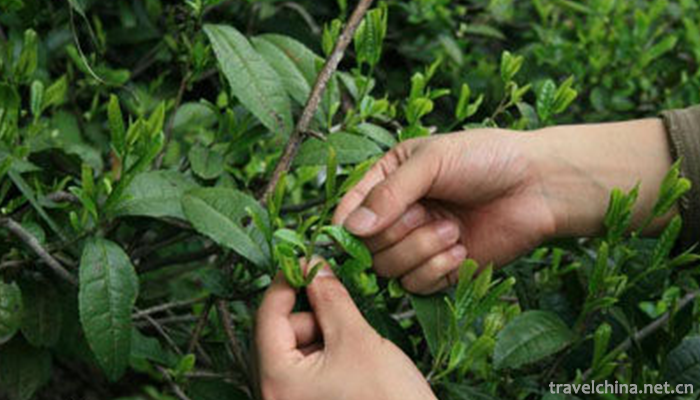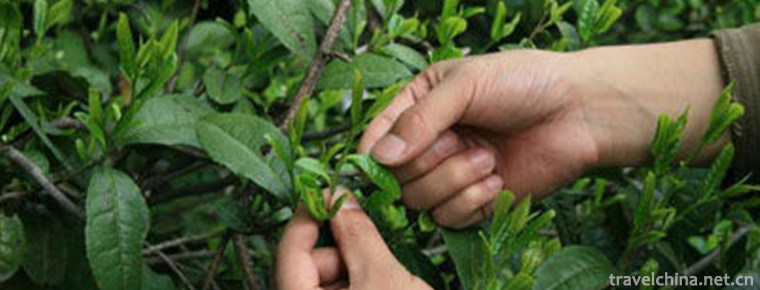Green Tea Production Techniques
Green Tea Production Techniques
Green tea production technology is a national intangible cultural heritage. Luan Guapian is a special kind of green tea. Cucumber seed-like flake-shaped tea is made from local endemic varieties by wrenching, removing tender buds and tea stalks, and through unique traditional processing technology. "Luan Guapian" has a long history and rich cultural connotation. As early as the Tang Dynasty, the "Tea Classic" was known as "Luzhou Lu'an (tea)"; Xu Guangqi, a scientist in the Ming Dynasty, in his book "Agricultural Administration Complete Book", called "Lu'an's piece of tea is the best product of tea"; Li Dongyang, Xiao Xian and Li Shishi in the Ming Dynasty also mentioned many times in "Yong Lu'an Tea", "seven bowls of Qingfeng from Lu'an" and "Lu Yu's legacy of the old classic", giving "Lu'an Gua tablet" a high level. Evaluation.
On June 7, 2008, green tea production technology (Luan Guapian) was approved by the State Council and listed in the second batch of national intangible cultural heritage list.
content
Luan Guapian is one of the top ten famous teas in China. It is an outstanding representative of traditional handmade tea. According to the historical records of Lu'an and the famous items listed by Yuan Mei, a literati in Qing Dynasty in Suiyuan Food List, Lu'an melon slices appeared in the middle of Qing Dynasty and evolved from "green big tea" in Lu'an tea. In the Qing Dynasty, Luan Guapian was listed as a famous tribute.
Luan Guapian Tea is located in the northern foot of the Dabie Mountains, around the Huangchaojian in Yuan District. The natural conditions and environment, such as temperature, light, rainfall, soil and so on, at an altitude of 400-600 meters, are especially suitable for the growth of Luan Guapian tea tree. The best "Luan Guapian" mainly distributes at the top of Qiyunchong Qishan Mountain, Mabu Town, Jinzhai, and 8 townships such as Longmenchong, Shipan Village, Dushan Town, Shibanchong Township and Hejiawan, Shipodian Township, Yuan District.
The picking process of Lu'an melon slices is divided into seven processes: picking, wrenching, frying pan, frying pan, pulling wool fire, pulling small fire and pulling old fire, among which the most distinctive one is "pulling old fire". "Laolaohuo" is the last baking, which has the greatest impact on the formation of special color, fragrance, taste and shape of Luan melon slices. Because the production technology of Luan Guapian is very difficult and the process is complex, especially the technology of pulling old fire is not a day's work, young people are reluctant to learn, and there are few successors. Luan melon slices are suitable for small and medium-sized leaf species in Dushan, Luan. Due to the introduction of other tea varieties, and the slow progress in the purification and rejuvenation of small and medium-sized tea varieties in Dushan, the degradation of suitable varieties is serious, and the original flavor of Luan melon slices is almost extinct, facing an endangered situation, which urgently needs to be protected.
The chemical constituents of Luan Gua tablets have very healthy effects. Its chemical composition is composed of 3.5-7.0% inorganic substances and 93-96.5% organic substances. There are about 27 inorganic mineral elements in tea, including phosphorus, potassium, sulfur, magnesium, manganese, fluorine, aluminium, calcium, sodium, iron, copper, zinc, selenium and so on. The main organic compounds in tea are protein, lipid, carbohydrate, amino acid, alkaloid, tea polyphenol, organic acid, pigments, aroma components, vitamins, saponins, sterols and so on.
Taste
Tea contains 20-30% leaf protein, but only about 3.5% can be dissolved in tea soup. Tea contains 1.5-4% free amino acids, more than 20 kinds, most of which are essential amino acids for human body. Tea contains 25-30% carbohydrates, but only 3-4% can be dissolved in tea soup. Tea contains 4-5% lipid, which is also necessary for human body.
Tea tasting embodies the social spirit of elegance, tranquility and harmony. There are four steps in the general tasting of Luan Guapian: tasting tea: observing the quality of tea from the color, tenderness and shape of dry tea. Smell: Appreciate the fragrance of tea after brewing. Guantang: Appreciate the process of ups and downs and stretching of tea during brewing, the dissolution of tea and the posture of tea after quiet brewing. Taste: Appreciate the color and taste of tea soup. Before drinking, it should be brewed with traditional methods such as "high-impact, low-pour, foam-inclusion, shower cover". Drinking, with the right index finger, thumb to hold the edge of the cup, middle finger to hold the bottom of the cup, jokingly known as "Sanlong Huding" tea taster in frying, focusing on the soup. For the color, aroma and taste of tea soup, color is the main form.
distinguish
Common sense of purchasing Luan melon slices. In normal temperature years, new tea can be produced within ten days before the grain rain, and tea plants with rich nutrition should be produced within a few days before and after the grain rain. Choosing and tasting "Lu'an melon slices" should usually grasp the following points: namely, considering the "color, aroma, taste and shape" of tea from two angles of dry tea and brewing tea.
One is the appreciation of dry tea. Watch color: through the wait-and-see should have iron green (deep green) emerald, tender, color and luster consistent, visible baking in place. Smell fragrance: The fragrance of tea, especially the fragrance or fragrance of burning chestnut, is superior by smelling; the explanation with grass flavor lacks the skill of stir-frying. Chewing taste: through careful chewing should have a sweet taste of bitter end, bitter in the thorough sweetness, a slight rinse with clean water after a refreshing and sweet feeling.
Appearance: Through inspection, the roll should be straight, similar in length, and uniform in thickness. It can be seen that the shape and size are the same and the stir-frying work is in place.
The second is the taste of dry tea hair soup. White porcelain cups (bowls) are commonly used for tea sets. Spring water or deep well water is preferred, and mineral water or pure water with near-neutral PH value is suitable without conditions. According to the capacity of tea set, put in the right amount of tea, light and moderate, not too much. In order to avoid the original fragrance of a piece of tea flowing away, some people advocate using boiled water to high-flush, slow collection, from pot to 2/3 of the tea set to cover for a moment (the new tender tea should not be fully covered). A moment later, you can taste it. The steps are as follows: First, smell the fragrance. Close to the mouth of the cup or bowl or mouth, feel whether there is a long tea fragrance; experience the fragrance of tea with its fragrance concentration. The second is to look at the color. The cup cover is used to help the tea to see the color of the soup. Generally, the green soup is clear and refreshing, without any turbidity. The color of its leaves is generally a new tea made from tea grass ten days before the grain rain. After soaking, the color of its leaves is light green and blue, which is not symmetrical. Close to the grain rain or after the grain rain, the leaf color is generally green or dark green, and symmetrical, the tea soup is correspondingly thicker, if the time is a little later, green and dark. And taste it. Usually, after two sips of tea soup slowly, then sip it fine and delicate. Normally, there are slightly bitter, cool and silky sweetness. The slices of tea made from nutritious leaves and brewed tea soup can make you feel the softness of the tea soup obviously. Fourth, look at its shape. After boiling water and making soup, dry tea first floats on the upper layer. With the opening soup of the leaves, the leaves one by one sink to the bottom of the cup and bowl one by one. The original strip shape was developed into leaf shape. The size of the blade was almost the same, and the sheets were superimposed.
"Lu'an slice tea" is one of the ten famous tea in China, and also one of the green tea series. It occupies the most important position in the green tea family. According to the results of modern pharmacological research, green tea is conducive to the prevention and suppression of cancer, the health treatment of cardiovascular diseases, the reduction of weight and the clearance of intestinal fat, the clearance of heat and dryness, detoxification and beauty.


-
1.Jining Beihu Tourist Resort
Jining is the world-famous town of Confucius and Mencius and the capital of the canal. Located 6 kilometers south of Jining City, Shandong Province, Beihu Lake is a new tourist attraction in Shandong
Time 2019-01-21 -
2.Mao Zedongs former Residence
Comrade Mao Zedong's former residence is located in Shaoshan Village, Shaoshan Township, Shaoshan City, Hunan Province. It is located in the South and north of Shaoshan Village
Time 2019-02-07 -
3.Mengfu Mengmiao Scenic Area Meng Temple
Mencius Temple, also known as Yasheng Temple, is located at 44 Yashengfu Street, Zoucheng City, Jining City, Shandong Province, where Mencius, a thinker of the Warring States Period, was sacrificed.
Time 2019-02-07 -
4.Zizhuyuan Park
Zizhuyuan Park is located in the West Third Ring of Beijing, near Baishiqiao in Haidian District, west of Beijing Capital Stadium. Zizhuyuan Park was built in 1953. It was named for the Ming and Qing
Time 2019-03-22 -
5.Stone carving
Stone carving is a traditional Chinese folk micro-sculpture process. The peach stone, apricot stone, olive stone and walnut are carved into handicraft products, which have been listed in the second ba
Time 2019-05-03 -
6.Story telling in Beijing dialect with drum accompaniment
Jingyun Dagu is one of the Chinese folk songs. Developed from the popular wooden drum in Cangzhou and Hejian of Hebei Province, it was formed in Beijing and Tianjin. After the introduction of Hebei wo
Time 2019-05-07 -
7.Qiang Mu Zashrunbu Temple Shigatse
Qiang Mu is a religious dance, also known as "Dancing God". "Semochim Qiang Mu" is a Tibetan Buddhist Gru-sect Qiang Mu performed by monks at Zashrunbu Monastery in Xikaze, Tibet.
Time 2019-06-11 -
8.Legend of Yin Jifu
The "Yin Jifu Legend" which was listed as the first batch of intangible cultural heritage in Hubei Province, made a sensation forum about "Chinese poetry ancestor, Taishi Yin Jifu of th
Time 2019-07-13 -
9.Zuo Gezhuang Club
Chongxin Village is located in Zuogezhuang, northeast of Wen'an County. Its economic prosperity and people's prosperity have become the material and cultural basis for the preservation and continuatio
Time 2019-08-16 -
10.Can Ding Zhens Pony pearl really run first
Recently, after the exposure of Ding Zhen's Pony pearl, many netizens have a question in their hearts: "can it really run first?"? After the news release, netizens have been hotly debated. The specific contents are as follows:
Time 2020-12-07 -
11.Famous people in Mianyang
Wenqi, Emperor chengdi of Han Dynasty, Guangwu people, Ziqi, Zhenyuan General of the Eastern Han Dynasty.
Time 2020-12-14 -
12.Dazhou culture
Baqu culture refers to the fact that Dazhou city is located in Bashan canal and belongs to Badi in ancient times. The chapter of Baqu customs is listed in the ancient book Taiping Huanyu Ji thousands of years ago; the second refers to the unique cultur
Time 2020-12-20